
Electron backscatter diffraction (EBSD) is a scanning electron microscopy (SEM) technique used to study the crystallographic structure of materials. EBSD is carried out in a scanning electron microscope equipped with an EBSD detector comprising at least a phosphorescent screen, a compact lens and a low-light camera. In the microscope an incident beam of electrons hits a tilted sample. As backscattered electrons leave the sample, they interact with the atoms and are both elastically diffracted and lose energy, leaving the sample at various scattering angles before reaching the phosphor screen forming Kikuchi patterns (EBSPs). The EBSD spatial resolution depends on many factors, including the nature of the material under study and the sample preparation. They can be indexed to provide information about the material's grain structure, grain orientation, and phase at the micro-scale. EBSD is used for impurities and defect studies, plastic deformation, and statistical analysis for average misorientation, grain size, and crystallographic texture. EBSD can also be combined with energy-dispersive X-ray spectroscopy (EDS), cathodoluminescence (CL), and wavelength-dispersive X-ray spectroscopy (WDS) for advanced phase identification and materials discovery.
The change and sharpness of the electron backscatter patterns (EBSPs) provide information about lattice distortion in the diffracting volume. Pattern sharpness can be used to assess the level of plasticity. Changes in the EBSP zone axis position can be used to measure the residual stress and small lattice rotations. EBSD can also provide information about the density of geometrically necessary dislocations (GNDs). However, the lattice distortion is measured relative to a reference pattern (EBSP0). The choice of reference pattern affects the measurement precision; e.g., a reference pattern deformed in tension will directly reduce the tensile strain magnitude derived from a high-resolution map while indirectly influencing the magnitude of other components and the spatial distribution of strain. Furthermore, the choice of EBSP0 slightly affects the GND density distribution and magnitude.[1]